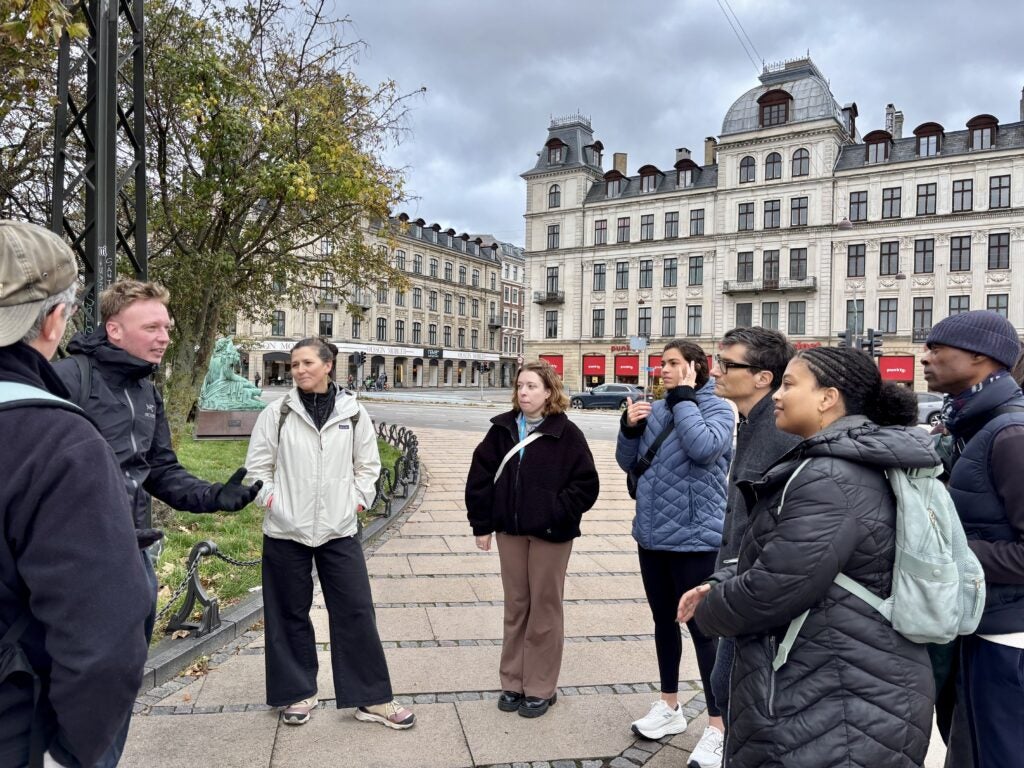Supporting Student Success in Global Health Education and Experiential Learning: A Dean’s Reflection
Posted in News Story | Tagged announcements, dis, Global Health, news story, Semester Program, study abroad
Written By Brian Floyd, MS
Academic Dean, Georgetown University School of Health
Faculty Member, Georgetown University Capital Applied Learning Lab
Georgetown University students interested in health, policy, STEM, and global learning have a unique opportunity to study abroad through the Danish Institute for Study Abroad (DIS), which offers immersive, interdisciplinary programs in Stockholm, Sweden, and Copenhagen, Denmark. For many years, Georgetown has valued DIS as a trusted partner, particularly for students in the School of Health seeking academically rigorous, experience-based global health education.

As an academic dean who advises students and faculty on impactful study abroad experiences—particularly within health-related disciplines—I recently participated in the DIS International Educators Workshop to explore, in depth, how DIS supports health education through its curriculum, fieldwork, and experiential learning model. This week-long program, held in both Stockholm and Copenhagen, offered first-hand insight into how DIS connects academic content with real-world public health, policy, urban development challenges, and research across science, technology, and health disciplines — and the collaborative solutions being developed and implemented by researchers, practitioners, organizations, and policymakers — reinforcing why it remains one of our most compelling global partners.
A Perspective from Academic Leadership and Student Advising
This unique experience began in Stockholm, where we attended classes, engaged in in-depth discussions with DIS faculty and staff, and met with professionals and stakeholders leading work in public health, policy, research, and urban development. These individuals and organizations are directly addressing the same issues students explore in the classroom, offering valuable insight into how place-based learning is constructed and experienced—and how it meaningfully shapes the student journey.
Stockholm: Curriculum Rooted in Place

While in Stockholm, I attended classes with students, including:
- Public Health Emergencies and Health-Crisis Management
- Public Health Policy in Practice
- Smart and Sustainable Cities
- Swedish Language and Culture
- A tour of STEM at DIS, including their Medical Simulation Lab
These sessions provided a firsthand view of the academic rigor and interdisciplinary integration that define the DIS approach. But Stockholm is more than just a backdrop for learning—it becomes an active teaching tool. The city’s walkable infrastructure, extensive public transportation, abundant green spaces, and sustainability-centered design vividly demonstrate how the built environment shapes health outcomes.
One concept that stood out was lagom—a Swedish word meaning “not too much, not too little—just right.” This idea of balance permeates Swedish society in many ways—whether seen through sustainable living, protected access to nature, gender equality, or comprehensive social welfare. It deepened my appreciation of health as more than the absence of disease—seeing it instead as a condition supported by harmony across systems: infrastructure and environment, policy and access, individual and community.
This is precisely the kind of thinking DIS programs encourage. Students use the city and its values as a lens to understand the connection between public health design and delivery and the built environment.
Copenhagen: The City as a Health Determinant
From Stockholm, we traveled by train to Copenhagen, where the focus continued to build upon the intersection of health, mobility, and urban design and sustainability. Here, students explore how daily movement—by bike, on foot, or via public transit—can influence both individual wellness and broader community cohesion when paired with economic fairness and social protection.
Courses and experiences I participated in included:
- Getting There: Transportation in Urban Europe
- European Urban Experiences: Why Cities Matter
- Social Change and Innovation through Food
- A field study visit: City as Your Classroom: Nørrebro – Cycling, Culture, and Urban Change
The visit to the Nørrebro neighborhood in particular highlighted how infrastructure choices support not only physical activity, but also social equity and cohesion — demonstrating how urban design can serve as a solution to pressing public health challenges. Copenhagen, like Stockholm, uses its urban design to drive health outcomes—an idea that has strong parallels to what’s possible in Washington, DC, and other cities where our students live and learn.
The City as a Living Laboratory

One of the most distinctive features of DIS is its commitment to learning beyond the classroom. Every course includes field studies, and many incorporate course-integrated study tours across Europe. This model encourages students to make tangible connections between academic content and real-world environments—whether examining public health systems or observing sustainable design in action.
This doesn’t replace traditional learning—it enhances it. The city becomes a living lab, where students reflect, engage, and apply what they’re learning in meaningful ways. It’s an approach that aligns closely with the values we promote at Georgetown’s School of Health.
A Faculty Perspective: How This Informs My Teaching
While I participated in the workshop as an academic dean, I teach courses at Georgetown grounded in experiential learning and the social and structural determinants of health. Observing how DIS builds academic content around site visits and hands-on engagement affirmed my own pedagogical approach.
Watching students explore public health in real-time—biking through Copenhagen, engaging with local organizations in Stockholm—strengthened my belief in the power of place-based learning. It continues to shape how I design course experiences and advise colleagues and students.
Why I Recommend DIS to Our Students

For students studying Global Health, Health Management & Policy, or Human Science in the School of Health, as well as those pursuing other majors interested in health, design, and society, DIS offers a transformative academic experience abroad. Students:
- Gain comparative insight into Scandinavian health systems, policy, sustainability, and research across science, technology, and health disciplines
- Participate in fieldwork and study tours that bring academic content to life
- Explore how urban infrastructure and design shape public health outcomes
- Develop cross-cultural understanding and practical skills for careers in health, research, or public service
DIS is more than a study abroad program—it’s a thoughtfully constructed educational model rooted in interdisciplinary, experiential, and global learning. For students ready to think critically and engage deeply with the world, I confidently and enthusiastically recommend it.
At Office of Global Education, we are committed to providing a range of undergraduate study abroad programs that can work for any school and any major. DIS Abroad is one of many programs that we offer that will work for you, especially for SOH and/or pre-health students. To learn more about DIS Abroad, click the link to explore the program brochures for DIS Copenhagen and DIS Stockholm. If you’re ready to begin the study abroad process, or simply want to learn more about your options, attend a Study Abroad 101.
